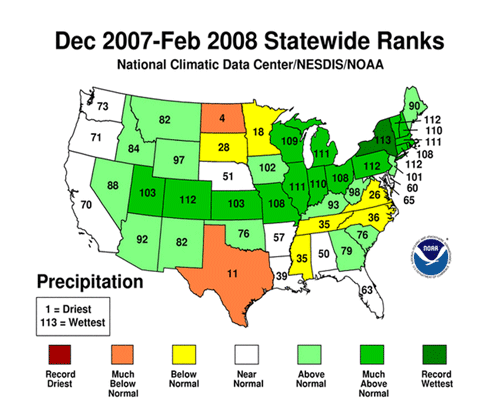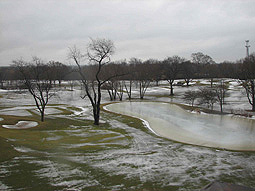Wet Winter Leads To Soggy Spring
The winter of 2007-08, which meteorologists classify as the months of December, January and February , will go down as one of the snowiest ever for the upper Mid-Continent Region, and much of the United States for that matter. For instance, Waterloo, Iowa received 47.7 inches of snow to mark its snowiest winter on record, and Rockford, Ill. recorded its second most snowfall with 63.4 inches. These are just two sites along with the entire region that received well above average snowfall.
 |
| Winter 2008 precipitation rankings. Source: NOAA. |
With warmer temperatures in recent weeks melting most of the snow and ice cover, nearly all courses have been, or still remain, swamped with soggy, saturated soils. Whereas the soil surface has thawed, frozen soils remain below thus impeding any downward movement of water through the soils.
Given that wet conditions in the upper soil profile are not conducive to traffic, it is likely that play in the upper Mid-Continent Region will be delayed until late March for most of Kansas and Missouri, whereas it will more likely be early April for many in upper Nebraska, Iowa and Illinois. For courses with poor overall drainage, however, it could be even longer.
As such, the following should be carefully considered in regards to selecting an opening date this spring:
 |
|
| Snow and ice retreat from a Chicago-land golf course in early March. Photo courtesy of John Gurke, Aurora CC. |
- Traffic is especially damaging during cycles of freezing and thawing typical of March. As grass blades and the upper few inches of the soil thaw with warmer temperatures, the ground underneath remains frozen, which causes water to dam at the surface. This is critical because:
- Soft, wet (i.e. slushy) soils are extremely susceptible to compaction. Pedestrian and vehicular traffic may easily cause surface bumpiness and/or rutting that requires months of core aeration, topdressing, and rolling to smooth the surface
- Traffic may cause a shearing action across the roots, rhizomes, and growing points of the plant, which is comparable to cutting the roots using a sod cutter. Root damage at this critical juncture can lead to long-term turfgrass health problems and jeopardize course conditions throughout the golfing season.
- Late winter/early spring play will cause the turf to thin, as it is not yet actively growing and recovery will not occur until temperatures warm enough for vigorous turf growth to resume. Consequently, voids in the turf canopy are filled with actively growing weeds, such as Poa annua.
- During heavy frosts typical of March and April, pedestrian and cart traffic cause ice crystals between the cells of turf plants to puncture the cell membranes, thus killing plant tissue.
- Lastly, play during wet soil conditions at this time slows spring green-up by hindering the turf's ability to transition out of winter dormancy. Lingering effects will surely disrupt spring golfing activities and, depending on the severity of traffic damage, the entire golfing season may be adversely impacted.
Simply put, if excellent conditioning during peak season play is of any importance, then exercising caution now should take precedence. This being the case, it is best for golfers to remain patient, take in March Madness, anxiously await the Masters, and allow the superintendent and knowledgeable course officials to determine a proper opening date so that you can enjoy a better golf course come summer.
If you would like more information about a Turf Advisory Service visit, do not hesitate to contact either of the Mid-Continent regional offices: Ty McClellan at tmcclellan@usga.org or (630) 340-5853 or Bud White at budwhite@usga.org or (972) 662-1138.
![]()
